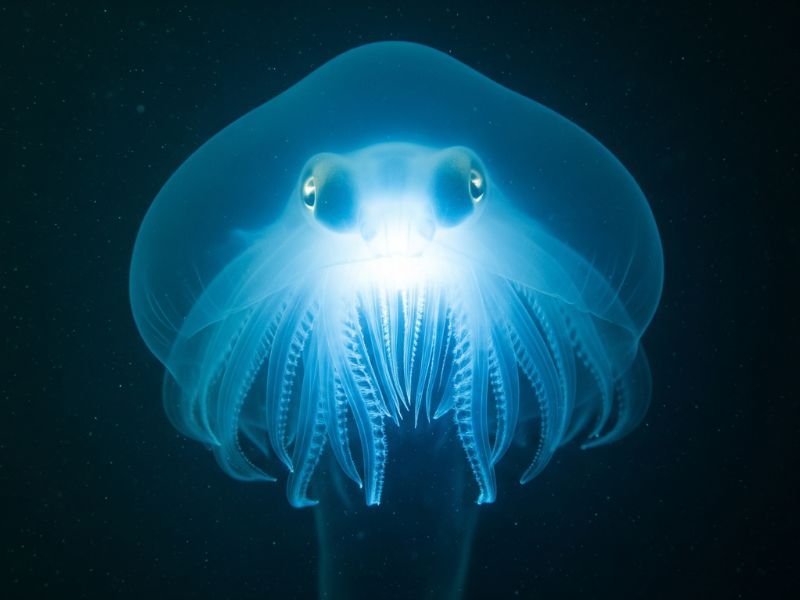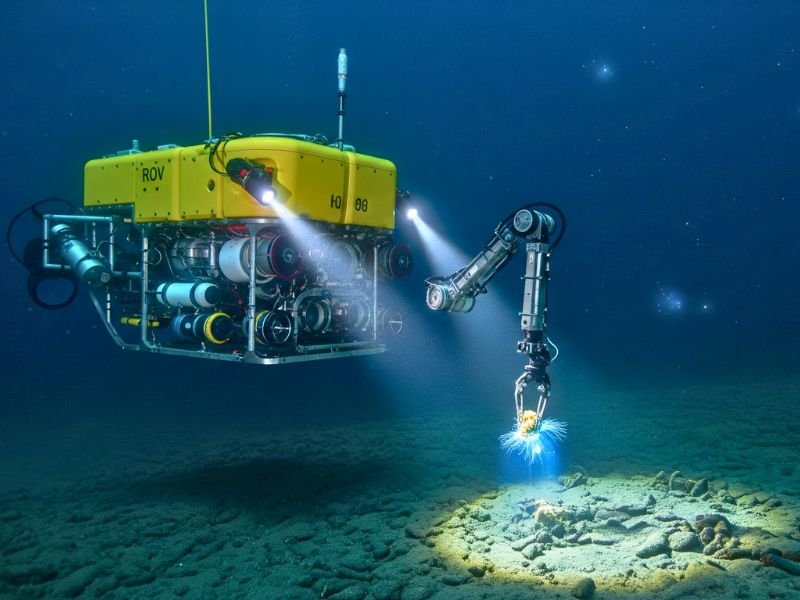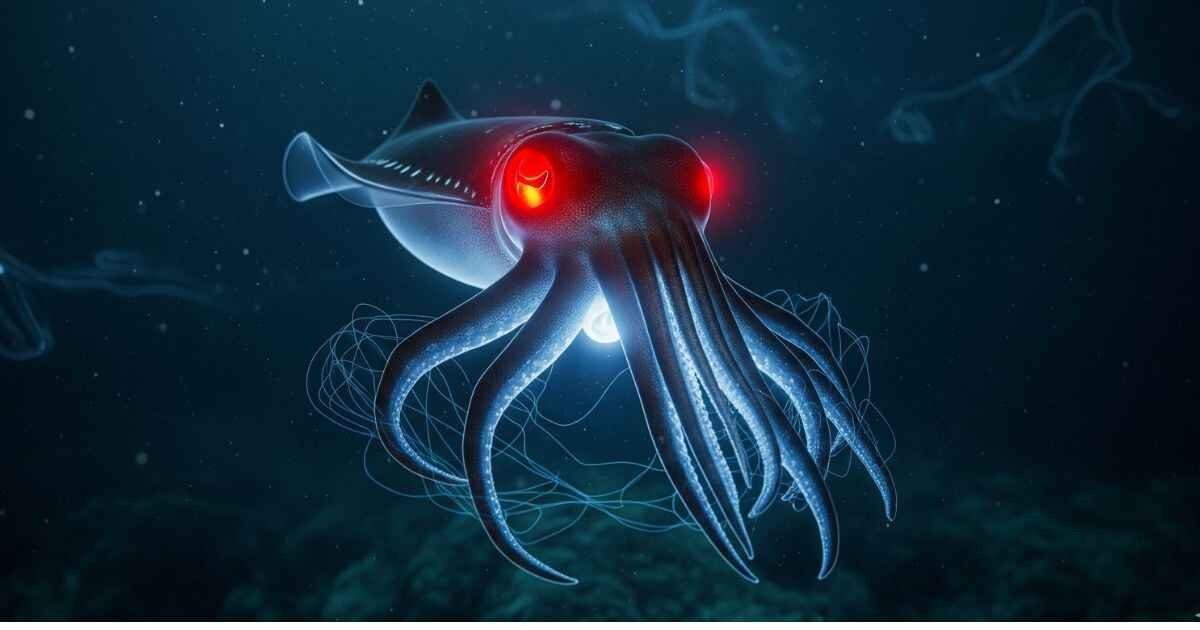Have you ever wondered if aliens live in the ocean? Some people think that strange creatures deep underwater might be like aliens. Scientists are curious too. They study oceans to find out if unknown life exists far below the surface. The ocean is very big and dark. Some parts are still a mystery. Deep sea creatures live in places humans can hardly reach. These creatures sometimes look very strange, like they came from another world. In this article, we will explore the real science, weird discoveries, and myths about aliens in the ocean.
What Do Scientists Mean by “Aliens in the Ocean”?
When scientists say “aliens in the ocean,” they do not mean real aliens from space. They mean creatures and lifeforms that are strange or not well-known. Many deep sea creatures live far down where sunlight cannot reach. These animals can look very odd. Scientists call them mysterious ocean beings.
The ocean is very deep. Some parts are still unexplored. People have found underwater anomalies, which are things that do not match what we expect. For example, some fish have glowing bodies, and some crabs have hairy arms. Scientists explore these areas with submarines and robots.
Over the years, scientists have discovered some amazing creatures. Here is a small table of famous deep sea discoveries:
Famous Deep Sea Discoveries and Their Mysteries
| Discovery | Year | Location | Mystery / Significance |
|---|---|---|---|
| Giant Squid | 2012 | Pacific Ocean | Rare deep-sea predator, rarely seen |
| Comb Jelly | 2000s | Global oceans | Moves in strange ways, glows in the dark |
| Deep-sea Vent Life | 1977 | Galápagos Rift | Lives without sunlight, survives in hot vents |
These discoveries show that the ocean has many secrets. Some animals look very unusual, and we do not know all of them yet. Scientists study them to understand how life can survive in extreme conditions. This research helps us learn more about Earth and even other planets with oceans.
How Do We Explore Alien Oceans?
Scientists use special tools to study deep oceans. The ocean is very dark and very deep. People cannot go there easily. So, researchers use submarines, robots, and remote tools. These machines help them see deep underwater and collect samples. This is called ocean exploration.
Studying Earth’s oceans also helps scientists think about alien oceans on other planets and moons. For example, NASA looks at Europa and Enceladus, icy moons far from Earth. These moons might have oceans under their ice. Studying them is called space ocean analogs. Scientists compare these moons to Earth to understand how life could exist in extreme water worlds.
Exploring deep oceans has pros and cons:
Pros of Deep-Sea Exploration
- Discover new species and lifeforms.
- Learn about Earth’s history and climate.
- Test new technologies for space missions.
Cons of Deep-Sea Exploration
- Very expensive and slow.
- Equipment can break under high pressure.
- Some areas are too dangerous for humans.
Tools and Techniques for Underwater Exploration
To explore, scientists use:
- ROVs (Remotely Operated Vehicles): Robots controlled from a ship to take pictures and samples.
- Submersibles: Small submarines that can carry humans deep underwater.
- Sonar Mapping: Sound waves that show shapes of the ocean floor.
- Water Sampling: Collecting water to study tiny lifeforms and chemicals.
These tools help scientists find strange underwater animals and learn about weird ocean life. Some animals look like they came from a sci-fi story, so people call them marine cryptids.
Lessons from Space Ocean Studies
NASA studies icy moons as a way to learn about alien water worlds. Europa and Enceladus may have oceans under thick ice. These oceans could have conditions like deep Earth oceans. By studying space ocean analogs, scientists learn how life might survive far from the Sun.
They also study how water moves, what chemicals are present, and how energy from heat vents could support life. These lessons help us imagine what alien marine life might look like in other planets’ oceans.
Also Read: Why Do Cruise Ships Get Stuck? Explained Simply
Could Alien Life Exist in Our Oceans?

Could there really be alien life in our oceans? Scientists say the ocean is full of unknown species. Many creatures live in deep water where light does not reach. Some are microorganisms too small to see. Others glow in the dark, which is called bioluminescence. Extremophiles are tiny creatures that survive in extreme heat, pressure, or cold.
Some people imagine intelligent underwater beings, but science has not found them. Most discoveries show unusual but natural life.
Scientific Evidence
Scientists have found life adapted to extreme conditions. Deep-sea life forms show traits that seem alien-like. For example, some glow, have strange shapes, or live without sunlight.
Here are some of the most strange and alien-like creatures scientists have found in the deep ocean.
Alien-Like Deep Sea Creatures in Our Oceans
Vampire Squid
Depth: 2,000–3,000 m
Unique Trait: Bioluminescence
Alien-Like Feature: Glowing body, unusual movement
Yeti Crab
Depth: 2,200 m
Unique Trait: Hairy claws
Alien-Like Feature: Feeds on bacteria, alien look
Comb Jelly
Depth: 1,000–2,000 m
Unique Trait: Glows, moves strangely
Alien-Like Feature: Neon-like movement
Glass Sponge
Depth: 500–1,500 m
Unique Trait: Transparent skeleton
Alien-Like Feature: Unusual skeletal structure
These creatures may look like aliens, but they are natural life forms adapted to extreme conditions.
Myths vs Reality
Not everything you see online is real. Some videos are AI hoaxes. Others show UFO claims in oceans. Many “alien” sightings are misidentified creatures. Comb jellies, giant squids, or strange fish often appear in videos. Real science uses careful observation and research, not social media claims.
Exploring the ocean teaches us truth about unknown species. It shows real deep-sea phenomena and clears myths about alien life underwater.
Are Aliens in the Ocean Dangerous or Safe?
Some deep-sea creatures can be dangerous. The ocean is full of oddities. High pressure, very cold water, and strong currents make the deep sea unsafe for humans. Some animals, like giant squids or venomous fish, can hurt people if touched.
But most deep-sea creatures are far from humans and not aggressive. Exploring them safely requires robots or submarines.
Pros of Studying Deep-Sea Life
- Learn about strange creatures and ocean life oddities.
- Discover new species and unusual traits.
- Understand how life survives in extreme conditions.
Cons and Risks
- Dangerous pressures and darkness.
- Some predators and toxic species.
- Equipment failures can happen in deep water.
Advice for Ocean Enthusiasts:
- Never dive into unknown deep waters without experts.
- Learn about the creatures from documentaries and scientific reports.
- Use safe tools like ROVs or remote cameras to explore.
Notable Reports and Sightings
Many people have reported strange things in the ocean. Some sightings are credible, while others are hoaxes. Scientists look for proof before believing.
Credible Reports:
- Deep-sea cameras captured unknown species moving in odd ways.
- Scientists have found glowing or transparent animals that look alien-like.
Hoaxes and Myths:
- Viral videos sometimes show fake creatures made by AI.
- Some “UFOs” in oceans are misidentified submarines, jellyfish, or waves.
Scientists check their discoveries using many cameras, lab tests, and DNA to make sure they are real.
Popular Culture Influence
Movies, documentaries, and popular videos make people think about aliens in the ocean. Science fiction shows smart underwater aliens, but real sea creatures are just strange, not from space.
Examples:
- Films about deep-sea monsters increase curiosity about marine science fiction.
- Viral videos show unusual animals but are often misinterpreted.
- Documentaries reveal mysterious marine species like comb jellies or vampire squids.
These stories help people learn about oceans but sometimes mix fact with fiction.
How Do Researchers Confirm Alien-Like Life?
Scientists use careful methods to confirm alien-like life in oceans. They take samples, analyze them in labs, and study DNA.

Methods to Identify Deep-Sea Life
| Method | Purpose | Example |
|---|---|---|
| DNA Analysis | Identify unknown species | Environmental DNA from water |
| Deep-Sea Cameras | Observe behavior | ROV footage of abyssal creatures |
| Chemical Analysis | Detect extremophiles | Hydrothermal vent samples |
These methods help researchers study alien water ecosystems and provide real evidence about deep-sea life.
Why Are Oceans Still a Mystery?
Oceans are still mysterious because they are very deep, dark, and dangerous. High pressure and cold make it hard for humans to explore. Many parts are unexplored.
Scientists do not have enough money or tools to study the ocean fast. In the future, missions like NASA’s Europa Clipper and deep-sea programs may find new animals. Scientists hope to discover unknown sea creatures and learn more about the deep ocean.
You May Also Like: JD Vance Dolphins Connection Shocks Everyone
Conclusion – The Real Truth About Aliens in the Ocean
The ocean is full of surprises. Some creatures look very strange, but they are real, not aliens from space. Scientists call them mysterious deep sea creatures. Studying them helps us learn about ocean life phenomena and how life survives in dark and extreme places.
Many stories about aliens in the ocean come from myths, movies, or fake videos. Science shows most life is unusual but natural. Exploring the ocean is exciting, but we should always check facts and think carefully. Curiosity is good, but learning with evidence is better. Real ocean life exploration can teach us amazing things about our planet and maybe even other worlds.
FAQs About Aliens in the Ocean
1. Could aliens really live in Earth’s oceans?
Scientists say most creatures in oceans are unusual but natural. No evidence of real space aliens exists underwater.
2. What deep sea creatures look like aliens?
Vampire squids, comb jellies, and yeti crabs look strange. They glow or have unusual shapes.
3. How do scientists explore the deep ocean?
They use submarines, ROVs, sonar, and water sampling to see and study deep sea life.
4. Are reports of underwater UFOs true?
Most reports are hoaxes or misidentified animals. Scientists verify sightings carefully before believing them.
5. What discoveries suggest alien-like life exists?
Some animals glow in the dark, some live in very hot or cold places, and some are see-through. They look strange, like aliens, but they are real animals.
6. Is it safe to explore deep ocean regions?
Not without experts. High pressure, cold, and dangerous animals make it risky. Robots and remote tools are safest.
7. Can studying the ocean help understand other planets?
Yes. NASA studies icy moons like Europa to compare alien water worlds with Earth’s deep oceans.
8. Why is the ocean still a mystery?
It is very deep, dark, and hard to explore. Limited funding and technology make it slow to learn all secrets.
Disclaimer
This article is for educational purposes only. It explores deep-sea creatures and unusual ocean life based on scientific research. Not all claims or sightings of “aliens in the ocean” are real. Readers should not assume these creatures are extraterrestrial or pose any danger without proper scientific evidence.

Shazny plays a key role behind the scenes, reviewing and refining content before it goes live. With a strong eye for detail, Shazny ensures that every article meets high standards of clarity, accuracy, and trustworthiness. From grammar checks to fact verification, Shazny helps maintain the quality and credibility of everything published on TryHardGuides.
Discover more from Try Hard Guides
Subscribe to get the latest posts sent to your email.




